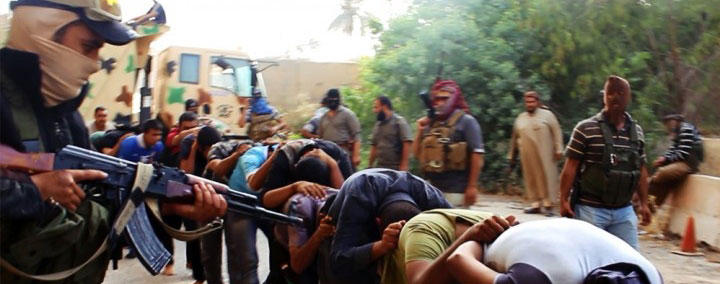Is the violent extremism that's fueling the Islamic State something new?

The world of violent extremism today is growing increasingly bizarre: teenage girls from an outer borough of London look for love with the men of the Islamic State, a soccer player from rural Australia seeks adventure in Syria, and thousands of militants from across the globe make their way to the Middle East. And so, the fight against jihadism — which is driven, inspired, justified, or associated with uncompromising ideology — has had to change, too, to become as diffuse and nimble as the jihadis themselves. Though the attempt to stop terrorism has been long, the meteoric rise of the self-styled Islamic State terrorist group has forced more and more attention to the concept of “countering violent extremism” (CVE), the practice of preventing extremism upstream rather than fighting it once it’s full grown.
But is the breed of extremism that has swept headlines different from what came before?
The drive to reverse the burgeoning growth of extremist fighters in conflict zones and the countries where these foot soldiers and their sympathizers originate makes it all the more important to ensure that, in the scramble for solutions, practitioners don’t get ahead of understanding the phenomenon that they’re dealing with. In truth, efforts to understand the nature of violent extremism, and solutions to counter and prevent it, have only just begun. Policymakers still have important questions to grapple with: Is violent extremism today different to from other forms of violence — including the political terrorism that has been more familiar to the West? What are the practical differences between countering violent extremism and preventing it?
Answering these questions will focus CVE efforts and minimize the prospect of old solutions simply being slapped with a new CVE label. Programs for countering an immediate threat need to be distinguished from long-term efforts to undermine extremism. And local partners can be selected on the basis of the different skill sets required for countering and preventing terrorism. Otherwise, CVE interventions will remain unfocused and merely float through the air, hoping to find a target.
Between 2005 and 2012, I lived in Afghanistan, serving for most of that time as a political officer and head of office for the United Nations political mission. That experience taught me how crucial it is to understand the social and political landscape in order to successfully counter violent extremism. The persistent recruiting appeal of the Taliban, for example, often lies far less in the group’s ideological appeal than in the reality of everyday life in Afghanistan, such as the fact that the majority of the country is under the age of 25 and largely unemployed.
Alienation bred radicalization, and after that, it’s pretty easy to identify consequences. An internationally supported program to strengthen police forces in Afghanistan, for example, stood accused in 2008 of accelerating the violence because the organizers failed to foresee that any new initiative would create losers as well as winners. In this case, a new district force was made up almost entirely of the dominant ethnic group, giving it a new lever of power. Imagine a young man of an already oppressed minority being constantly hit up at checkpoints, repeatedly beaten by the newly vested police force. Where should he turn but to the Taliban?
Violent extremism writ large may not be as easy to articulate, counter, and prevent. Discerning drivers of violent extremism will not be easy, particularly when the journey towards radicalization and violent extremism for an individual is deeply personal. Throughout the course of my own work, CVE practitioners from a diverse range of organizations have described violent extremism as a phenomenon for which old programming may well be sufficient. But CVE practitioners need to consider the possibility that violent extremism today is not just a reaction to governments whose legitimacy, authority, and capabilities are challenged. After all, poor governance is not a new phenomenon. Unlike the ideological pull that populated the ranks of political movements throughout the 20th century such as the Provisional IRA in Northern Ireland, young men and women resorting to violent extremism today may not necessarily have a political agenda, despite the rhetoric of groups like the Islamic State, which says it aims to create a caliphate.
Instead, CVE practitioners may need to consider that violent extremism stems from local communities that have fractured so much that traditional authorities can no longer manage the competing claims of individuals and their factions. Stability that hinges on community cohesion breaks down.
Anthropologists study the evolution of the modern world and its impact on societies and people. The CVE community might do well to do the same. In doing so, it might accept that violent extremism today may well constitute a new phenomenon for which new programming is required. Individualism, migration, evolving gender roles — and the confusion they breed, especially in young men — the information age, and unprecedented global wealth, and its inequitable distribution: does each inadvertently erode mechanisms that hold communities together and prevent violence? Could this combination of factors, representing society’s evolution, be partly responsible for groups such as the Islamic State being able to bring together a strange and diverse coalition of supporters? Practitioners would be foolhardy not to consider it.
Practitioners then need to consider the difference between countering violent extremism that’s occurring already and preventing it from happening in the first place. Countering violent extremism that is already occurring is more fraught than preventing it because the need is so immediate. Violent extremism is a highly sensitive and extremely politicized issue for leaders struggling to retain authority and control. And while we can all agree that countering violent extremism is best undertaken by local players responding to local issues, how do we engage when government itself may be the problem and refuses to recognize it? Military, police, and intelligence measures still dominate among practitioners countering the immediate needs which stem from violent extremism, but prevention is equally necessary, and governments across the world are looking for ways to prevent violent extremism and its predecessor, radicalization. The focus remains on developing governments’ skills to govern better, and on civil society to engage at the local level through activists who understand the terrain.
So how should the international community approach the challenge of countering violent extremism versus preventing it?
Iraq’s meltdown last year is a good example. In testimony before the Senate Foreign Relations Committee in September 2014, Secretary of State John Kerry left no doubt that sectarianism was a contributing factor to the underlying instability across Iraq that the Islamic State capitalized on as its forces swept through entire Iraqi towns. But even as Islamic State forces were welcomed by Sunni communities for whom Baghdad’s sectarian divides grew tiresome, the international community, according to experts such as Director of National Intelligence James Clapper, underestimated just how potent a force the Islamic State would be.
The resulting devastation illustrates why the ability to counter violent extremism requires in-depth knowledge of militant networks, especially the elements that disseminate and sustain the extremist narrative. It also demands knowledge of — and access to — the fence sitters, those who are sympathetic or acquiescent to extremist ideology, and those who have yet to decide in which camp they are in but who are vulnerable to extremist overtures. Disaffected Sunni tribes in Iraq or their counterparts in southern Afghanistan are examples of populations that, at a crucial moment, decided to throw in their lot with extremists who better represented their interests. Practitioners need to engage these populations before they get to that point, either directly or through local partners who are politically savvy, perceived as honest brokers, and understand the security risks involved.
This might be considered prevention, but it also constitutes countering militancy when you consider the easy access that extremists often have to disaffected populations and understand how quickly recruitment takes place. One final humiliation can tip the balance. And targeting the fence sitters provides the best opportunity to counter violent extremism. By supporting the community networks that already stand against extremism but might not be strong enough on their own to reverse the lure of militancy, we can push the undecided to one side or another.
CVE programming to respond to ongoing violence also requires interventions that are nimble enough to adjust based on what’s causing radicalization in any particular setting. And an effective approach sometimes calls for engaging undesirables, whether in the target country’s own government or in the militant networks themselves.
Prevention takes a longer-term view. It is more manageable because strategies can develop over time, informed by successes and failures, without the pressure of responding to immediate crises and the risk of doing so without enough information. Prevention can involve less disruptive activities that are more typically considered development, such as improving the competence of authorities to govern and thus easing discontent that can spur unrest. Development initiatives also tend to be more widely accepted by recipient governments — perhaps a little burdensome, but uncontroversial for the most part, and perhaps even beneficial to the authorities — and thus are more effective over time.
Whether they are trying to prevent or counter violent extremism, foreign institutions must have local partner organizations and individuals on the ground who know the terrain and can be trusted as implementers of initiatives involving a host of community players, from educators and health workers to police or religious leaders.
Violent extremism is both an individual and communal response to profound dissatisfaction with the larger world. It will not be easy to find a pattern to that dissatisfaction, or an effective response. Only an astute, self-critical, and longer-term application of knowledge and methodology can control and ultimately prevent violent extremism. And it will be important to not only craft prevention measures but also engage in countering the extremism flaring up now. Otherwise, those in counter-terrorism may well find themselves fighting alone.
Reposted with permission from ForeignPolicy.com, Source: “You Can’t Fight What You Don’t Understand"
